Today was going to be an exciting day, we were taking the train to the nearby town of Modena to tour the Giusti family balsamic vinegar-making farm. We got up and out the door a little before 8 and hopped on a nearby bus to take us to the train station.
Dropped just south of the train station, we passed the remains of the 14th century Rocca di Porta di Galliera. This once magnificent castle was the symbol of the Pope's control of Bologna. The castle was always the first symbol of oppression to be attacked by the people and, over the years, it was repeatedly destroyed and rebuilt. The castle was eventually completely destroyed and the ruins were used to build a city park (Parco Montagnola) in the 19th century.Next, we strolled by the Porta Galliera, one of the walled city's defensive gateways with a baroque facade, rebuilt in the 1600s on the site of a medieval structure.We boarded the train and after about 45 minutes, we arrived at the Modena train station. We hopped on a bus that whisked us past a huge outdoor flea market (FOMO) and eventually dropped us off in the middle of the town on the Via Emilia Centro. Dominating the Piazza Grande is the Duomo di Modena.
... a Romanesque cathedral with a bell tower, a 1400s rose window and ornate bas-relief carvings.While the cathedral was enchanting, we were keen to get to the city's historic market to see their best of local produce, meats and other specialties.
The Mercato Storico Albinelli was established in 1931, after being held outdoors in Piazza Grande for centuries. With the market's art nouveau structural style and beauty, it has been recognized as a monument of national interest.
The Mercato Storico Albinelli was established in 1931, after being held outdoors in Piazza Grande for centuries. With the market's art nouveau structural style and beauty, it has been recognized as a monument of national interest.
Upon walking into the covered market, we were struck by the cavernous space, and assulted by our senses of color and aroma.
We could only think to attack the space, isle by isle. Luckily, one of the first booths we found had coffee and pastries so we bolstered ourselves for the coming onslaught with a cappuccino and cornetto.
Not bad for the supermarket!
After second breakfast, we began our systematic review of all the market's wares.
Not bad for the supermarket!
After second breakfast, we began our systematic review of all the market's wares.
Fresh pasta on the drying rack...
Salamis, pepperonis, sun-dried tomatoes and more...
You want olives? We got those...
Cheese? Name it!
Eat your vegetables!
More pasta...
Porchetta, salami and mortadella...
Fresh bread, pasta and conversation...
Oh yeah, more pasta - gnocchi, passatelli, tortelinni (Venus' belly button)...
More local meats...
Fresh fruit...
Mozzarella...
How do you choose?
Lots of packaged tortellini, ravioli and other pastas...
The balsamic vinegar vendor displayed varieties based on age and process - foreshadowing our visit at the Giusti farm.
You want candy?
Booths and booths and booths of fresh produce...
Row upon row upon row of choices...
Stuffed, fried, baked...
Shimmering eggplants and tomatoes!
Zucchini flowers!
More vegetables...
Nuts and flour, jams and honey...
Leafy greens...
Prepared pasta...
Sun dried tomatoes (we bought some)...
We bought a huge wedge of Parmigiano Reggiano from this vendor.
The deli counter...
The liqueur store...
We finally exited out of the Mercato Albinelli onto the Piazza XX Settembre, not quite set up for the day's outdoor dining.
Salamis, pepperonis, sun-dried tomatoes and more...
You want olives? We got those...
Cheese? Name it!
Eat your vegetables!
More pasta...
Porchetta, salami and mortadella...
Fresh bread, pasta and conversation...
Oh yeah, more pasta - gnocchi, passatelli, tortelinni (Venus' belly button)...
More local meats...
Fresh fruit...
Mozzarella...
How do you choose?
Lots of packaged tortellini, ravioli and other pastas...
The balsamic vinegar vendor displayed varieties based on age and process - foreshadowing our visit at the Giusti farm.
You want candy?
Booths and booths and booths of fresh produce...
Row upon row upon row of choices...
Stuffed, fried, baked...
Shimmering eggplants and tomatoes!
Zucchini flowers!
More vegetables...
Nuts and flour, jams and honey...
Leafy greens...
Prepared pasta...
Sun dried tomatoes (we bought some)...
We bought a huge wedge of Parmigiano Reggiano from this vendor.
The deli counter...
The liqueur store...
We finally exited out of the Mercato Albinelli onto the Piazza XX Settembre, not quite set up for the day's outdoor dining.
We walked towards the Via Emilia Centro where we could catch a taxi to the Giusti Family balsamic-making facility. Heavenly parasols seemed to brighten the sky where ever we went.
From Modena, we grabbed a taxi, but it ended up being a mess because there was an accident on the highway and it was shut down. Our driver struggled to reroute but we eventually made it. What should have been a 15 minute drive ended up being an hour adventure and we were about $60 in the hole.
Here's a picture of the Giusti family compound taken from their website.
Traditional balsamic vinegar is produced from the juice of just-harvested white grapes, typically, Trebbiano grapes, boiled down to reach a minimum sugar concentration of 30% (brix) or more, which is then fermented with a slow aging process which further concentrates the flavors.
When we started our tour, we first looked at the barrels used for the aging process.Giusti's collection includes 5 varieties of balsamic vinegar, differentiated from each other by their specific recipes and aging processes, and classified by a series of medals.
Here you can see a barrel marked (bottom) with the barrel material, recipe, duration of aging, etc. These barrels are used over and over for centuries.
Following a centuries-old oral tradition, Giuseppe Giusti was one of the first to write down the rules for obtaining a “perfect Balsamic Vinegar”. His text, composed in 1863 for the Modena Agricultural Fair, specifies how the choice of grapes, the quality of the barrels and time (aging) are the fundamental ingredients in making quality balsamic vinegar.
The magic of balsamic is influenced by the wood used in ancient barrels used to slowly age the the vinegar. One of the things that makes Acetaia Giusti balsamic so special is their vast collection of historical, centuries-old barrels still in use today in its aging rooms.Their vinegar production takes place in a loft and its unique microclimate allows them to attain their signature flavors.
Aging is another important part of the balsamic vinegar production process: the older the barrel, the better the balsamic vinegar will be, as the cask increasingly imparts the aroma of the fine wood and that of all the balsamic vinegar that has aged therein over the years.
Many of these smaller casks have been aging for decades.
The casks are routinely inspected over the aging process. To inspect, the vinegar is sucked up into a glass "pipette" and then it's thickness/color is evaluated against a background of candlelight.
The casks are routinely inspected over the aging process. To inspect, the vinegar is sucked up into a glass "pipette" and then it's thickness/color is evaluated against a background of candlelight.
The master vinegar maker is responsible for constant quality checks, taking into account the rich and glossy dark brown color, the intensity of aroma, and the subtle hints of the grapes and barrel wood used and the sourness of the acidification process.
At Giusti, the family art, preserved through generations, guarantees the quality and taste of a condiment that defies time.
These small family casks on the shelves in the background have been aging for hundreds of years and are only tapped for very special occasions.
We ended our tour in the tasting room where we could educate our palettes to discern the differences in taste from the different recipes and aging process.
We ended our tour in the tasting room where we could educate our palettes to discern the differences in taste from the different recipes and aging process.
You also learn about other vinegar additives some companies use to dilute the original balsamic ingredients to get more volume and that influences taste and cost.
The aged balsamics are meant to be used sparringly, drizzled on or around cheeses, main courses or desserts, to add just a hint of that intense flavor.
When purchasing balsamic vinegar, check to see if the labelling signifies that the balsamic is "DOP" (Denominazione di Origine Protetta - Protected Designation of Origin) which indicates a high-quality, traditionally made product from a specific region, or "IGP" (Indicazione Geografica Protetta - Protected Geographical Indication) which means the product is made in a specific geographical area, but the process may not be as strictly regulated as DOP.
Here's how Giusti characterizes their IGP varieties (in order, cheapest to most expensive):
2 Gold Medals: A classic and versatile dressing, perfect for use either fresh or heated in cooking preparations. It has a good density and an optimal balance between sweet and sour, with notes of ripe fruits, licorice, and black pepper.
3 Gold Medals: Made from sweet, sundried grapes and aged in oak barrels. The aromas and flavors of plum jam and red fruits blend with hints of honey and vanilla, creating a dense and sweet product. Ideal as a fresh dressing for both savory and sweet dishes.
4 Gold Medals: Aged for a long time in acacia barrels, it offers a deeply aromatic flavor with scents of ripe fruits, accompanied by notes of tobacco, roasted coffee, and hints of wood and honey.
5 Gold Medals: The ultimate expression of Giusti vinegars, this robust elixir is distinguished by its extraordinary complexity and rich bouquet of aromas. It features notes of black cherries and sweet spices, with marked fragrances of the ancient woods in which it aged, offering a long-lasting taste. We purchased this one!
Traditional Balsamic Vinegar of Modena, refined - extra old: Derived solely from cooked must, Traditional Balsamic Vinegar of Modena. This is DOP, both unique and precious.
After the tasting room, we circled back to the Giusti museum, where they had displays on the varieties of grapes that they use...
The museum included a series of casks used to split vinegar into batches that would age longer and longer.
The museum had information about traditional practices, like when a cask of vinegar is given as a wedding gift or given to a couple at the birth of a child, which is then opened when the child marries.
Below are examples of the old traditional equipment used to transport balsamic for sale.
The museum teaches how Giusti family members helped to grow their business by traveling to fairs and exhibitions throughout Europe to boost awareness about the quality of their products.
As a result of their promotional activities, using their "Black Gold of Modena", Giusti family balsamic vinegar won prestigious medals between the 19th and 20th centuries.
The museum included some antique Giusti family documents and artifacts, demonstrating their long history of involvement in the production of balsamic vinegar.
Their historic label...
After our visit, with purchased balsamic in tow, we needed to get back to Modena. Not wanting to repeat the taxi debacle from the morning, we opted to walk about a mile along country roads to the local train station. We hustled to make sure we could catch one of the infrequent trains back to Modena and then it only took about 20 minutes to get back to the city.
We wandered about the city, taking in the sights, but by about 2:30 realized we were pretty hungry so Kathi hunted down a shop to get a typical type of sandwich. We found it here at Bar Tiffany, along with some nice outdoor seating under a lovely portico.
Nearing apertivo time, we stopped in the Piazza Roma at the Osteria de Modena Rossi for a "glass of truth".
After our wine break, I spied the Chiesa di San Domenico, a Baroque-style Roman Catholic church. It replaced a prior church that was torn down around 1707 to make way for the expansion of the Ducal Palace in Modena.
Below are examples of the old traditional equipment used to transport balsamic for sale.
The museum teaches how Giusti family members helped to grow their business by traveling to fairs and exhibitions throughout Europe to boost awareness about the quality of their products.
As a result of their promotional activities, using their "Black Gold of Modena", Giusti family balsamic vinegar won prestigious medals between the 19th and 20th centuries.
The museum included some antique Giusti family documents and artifacts, demonstrating their long history of involvement in the production of balsamic vinegar.
In the 18th and 19th centuries, there were only a few types of bottles; the most common were 1-liter wine bottles, which were produced from glass-blowing and were very expensive. They were made with very thick green or black glass, the kind used for Lambrusco, a local sparkling wine. The bottles were closed with a cork and sealed with wax (see above, left). The Giusti family also used ceramic containers so they could control the vessels with different capacities.
After our visit, with purchased balsamic in tow, we needed to get back to Modena. Not wanting to repeat the taxi debacle from the morning, we opted to walk about a mile along country roads to the local train station. We hustled to make sure we could catch one of the infrequent trains back to Modena and then it only took about 20 minutes to get back to the city.
We wandered about the city, taking in the sights, but by about 2:30 realized we were pretty hungry so Kathi hunted down a shop to get a typical type of sandwich. We found it here at Bar Tiffany, along with some nice outdoor seating under a lovely portico.
The sandwich consists of some thinly sliced mortadella inside a crispy pastry shell. Kathi estimated correctly that I would want two! Topped off with a bottle of frizzante, what more do you need?
Re-energized, we continued to wander, bright, floating umbrellas adding whimsy to a blue sky.Nearing apertivo time, we stopped in the Piazza Roma at the Osteria de Modena Rossi for a "glass of truth".
After our wine break, I spied the Chiesa di San Domenico, a Baroque-style Roman Catholic church. It replaced a prior church that was torn down around 1707 to make way for the expansion of the Ducal Palace in Modena.
Speaking of which, the Palazzo Ducale di Modena is quite massive, taking up a commanding position in on the north side of the Piazza Roma.
The palace was the residence of the Este Dukes of Modena between 1452 and 1859. It currently houses a portion of the Italian Military Academy and military ceremonies often take place in the adjoining piazza. (Osteria Rossi is in the lower right of the picture above)
The palace was the residence of the Este Dukes of Modena between 1452 and 1859. It currently houses a portion of the Italian Military Academy and military ceremonies often take place in the adjoining piazza. (Osteria Rossi is in the lower right of the picture above)
Walking south on the Via Farini towards the center of Modena, we came across the beautiful Chiesa di San Giorgio, built in the mid-1600s.
Saint George is highly respected and honored throughout Italy. According to tradition, he was a soldier in the Roman army and later became a member of the Praetorian Guard for Roman Emperor Diocletian. He was sentenced to death for refusing to recant his Christian faith and has been especially venerated as a military Saint since the Crusades. Is it coincidence that this church is so close to the Italian Military Academy in the Palazzo Ducale?Continuing south, more umbrellas on the Via Ceare Battisti (with the tower of the Duomo di Modena in the background).
We eventually made our way back to the city center to explore the Duomo di Modena - "the house of San Geminianus", the patron saint of Modena (312-397). The duomo was built over his tomb. Saint Geminianus (also known as Saint Geminian or Saint Gimignano) is typically depicted as a bishop holding a model of the town of Modena, a man calming a storm at sea or exorcising the daughter of the Byzantine emperor Jovian.
We eventually made our way back to the city center to explore the Duomo di Modena - "the house of San Geminianus", the patron saint of Modena (312-397). The duomo was built over his tomb. Saint Geminianus (also known as Saint Geminian or Saint Gimignano) is typically depicted as a bishop holding a model of the town of Modena, a man calming a storm at sea or exorcising the daughter of the Byzantine emperor Jovian.
This example is from the eponymous Tuscan Town.
The Cathedral, as many of the churches of the same period, is built in a west-east direction. It is decorated with loggias closed under arches, and adorned with wonderful capitals and statues. Three doors are open to the outside, though originally only the central one existed.
The Porta dei Principi, (Princes’ Gate, above) looks onto Piazza Grande, embraces the faithful and tells them of the history of Saint Geminianus, the patron saint of Modena, visually represented and transformed into narrative with images of a unique quality.
The column-bearing lions are Roman, probably taken from an ancient grave. The curved exterior face of the arch is decorated with a rich acanthus tree supported by two male figures supporting the columns (telamons), where men, bizarre and natural beings are intertwined - a basilisk, a mermaid, a griffin, vipers, hawks, cranes, etc.
The column-bearing lions are Roman, probably taken from an ancient grave. The curved exterior face of the arch is decorated with a rich acanthus tree supported by two male figures supporting the columns (telamons), where men, bizarre and natural beings are intertwined - a basilisk, a mermaid, a griffin, vipers, hawks, cranes, etc.
Numerous reliefs, including the four famous panels with the stories of Genesis, decorate the façade. These reliefs are placed above the lateral portals and next to the central one, and are divided into twelve parts, ranging from the representation of God in a mandorla to the Great Flood. They were placed at eye level so that people who could not read were able to find the illustrations of the biblical stories they had heard about.
Below is the "Porta della Pescheria" (Fish-Market gate). Like the Prince's Gate, it includes two sculpted Telamons who appear to be asking anyone who crosses the threshold for help in carrying their huge burden. The inside door frame depicts the twleve months of a man's work portrayed as agricultural workers busy in the fields. Fantastic tales feature on both the door's unusual archivolt, carved with the adventures of King Arthur in Bretagne, and on both door frames and the architrave where animals from ancient fables by Phaedrus and Roman de Renard emerge from intricate tangles of plant life.
Inside, the high vaulted ceilings, simple stone walls, and dim lighting create an atmosphere of reverence and reflection. The central nave is flanked by two aisles, divided by rows of sturdy columns that guide the eye toward the altar. The pulpit, supported by two hunchbacks was built in 1322.
The crypt houses the sepulchre of San Gemimianus, patron saint of Modena, and it's one of the most spiritually significant parts of the cathedral. The saint’s relics rest in a modest 4th-century urn, covered by a stone slab supported by four columns.
The side alters are both simple and elaborately ornate. I can't even imagine the craftsmanship that it took to carve this wooden alterpiece.
Below, the apse's beautifully-gilded dome lights up the space, highlighting rich candelabrums, a marble altar and the golden XIX-century tables with Santa Lucia and Sant’Eligio. On the wall are the remains of paintings that once overed the interior of the Duomo between the 13th and 14th centuries.
The side alters are both simple and elaborately ornate. I can't even imagine the craftsmanship that it took to carve this wooden alterpiece.
Below, the apse's beautifully-gilded dome lights up the space, highlighting rich candelabrums, a marble altar and the golden XIX-century tables with Santa Lucia and Sant’Eligio. On the wall are the remains of paintings that once overed the interior of the Duomo between the 13th and 14th centuries.
In the nave, there is a 13th century enclosure. The floor is decorated with marble designs. The main alter, dating back to the 13th century, is supported by six pairs of columns and a bigger, spiral one, symbolizing Christ among the 12 Apostles. The paintings in the apse are more recent, carried out in the 19th century, inspired by the classical themes of the Roman mosaics.
Looking back, towards the rose window, flooding the space with light!
Near the entrance of the Modena Cathedral, you’ll find a curious artifact known as the Osso di Drago, or Dragon’s Bone. This large bone, which hangs from a chain, has been a source of legend and intrigue for centuries. While some believe it belonged to a mythical dragon slain by Saint Geminiano, historians suggest it is likely the rib of a prehistoric whale or a dinosaur bone, brought to Modena during the Middle Ages as a relic or curiosity. For locals, the Osso di Drago symbolizes protection and mystery, tying the cathedral to the realm of legends and adding another layer to its already rich narrative.The bell tower was built for the cathedral, but has played an important civic function since its origin. The ringing of its bells marked the time for life in the city, it announced the opening of the gates in the city walls and acted as a warning system for the people in situations of alarm or danger.
Together with the Ghirlandina belltower and Piazza Grande, the Duomo di Modena has been designated as a UNESCO World Heritage Site since 1997.
Together with the Ghirlandina belltower and Piazza Grande, the Duomo di Modena has been designated as a UNESCO World Heritage Site since 1997.
Also on the Piazza Grande is the Comune di Modena, the local town hall.Just up the Corsa Duomo, we came across the Chiesa della Madonna del Voto. The church was built to fulfill the vow made by the people of Modena to the Madonna della Ghiara, so that she would put an end to the plague of 1630. It is modeled after the Bolognese church of San Salvatore with the dome resembling the Basilica of the Madonna della Ghiara in Reggio Emilia, where the miraculous image of the Virgin is venerated.
We found a place to eat in the Piazza Giuseppe Mazzini, at the restaurant Uva d'Oro (translated to be "golden grape"), but we had to wait a bit for the outdoor seating to be set up. While we were waiting, we were entertained with a traveling band.
Does this even happen in the U.S.?!
Finally the restaurant opened and we grabbed a spot overlooking the piazza. Kathi had gnocchi con ragu e mozzarella and basil while I opted for the tortellini alla panna (with creme). Combined with a refreshing red wine - hard to beat!
We finally gave up our seats at around 8:30, now to a packed house.We walked lazily back to the train station and made our way by train back to Bologna, and then on to the Residenza del Duse for a well deserved sleep. It would be our last night in Bologna; tomorrow we would head back to the outskirts of Venice and stage for our flight home. (deep sigh...)






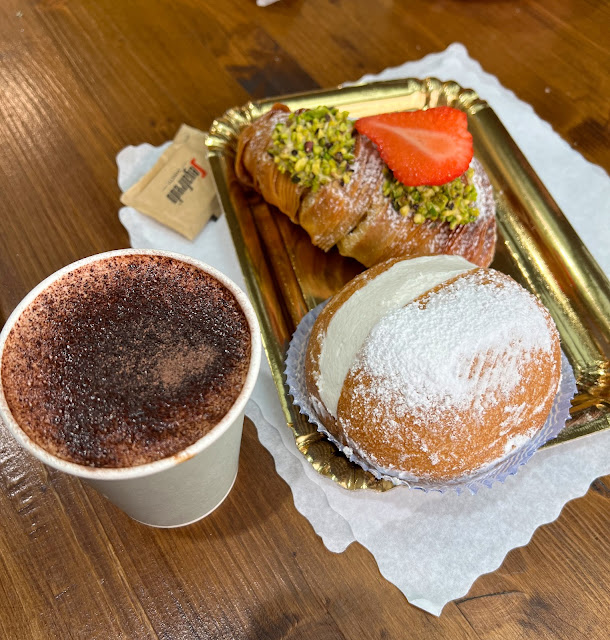




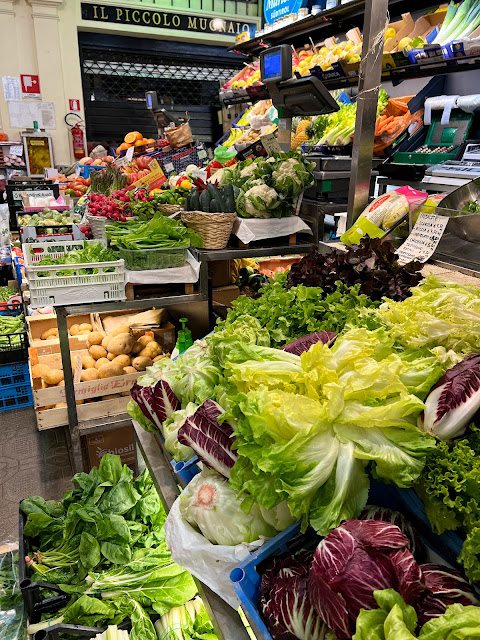
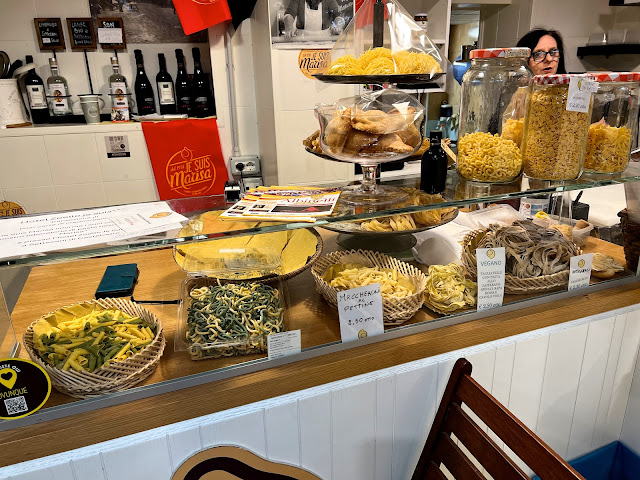







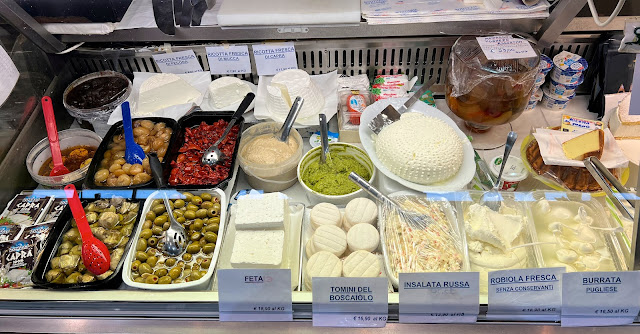





































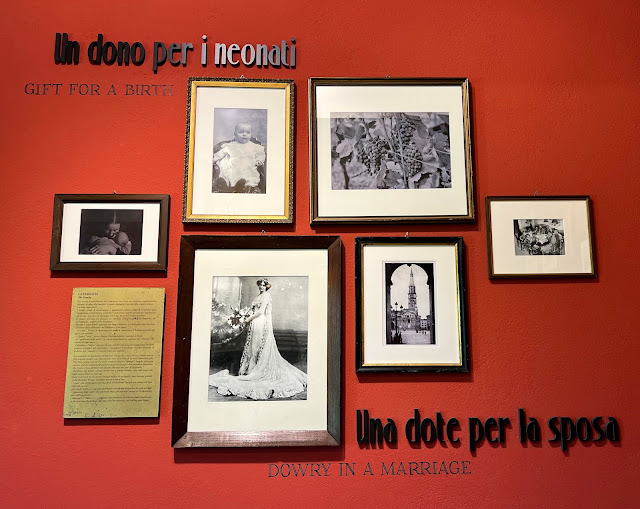






























No comments:
Post a Comment